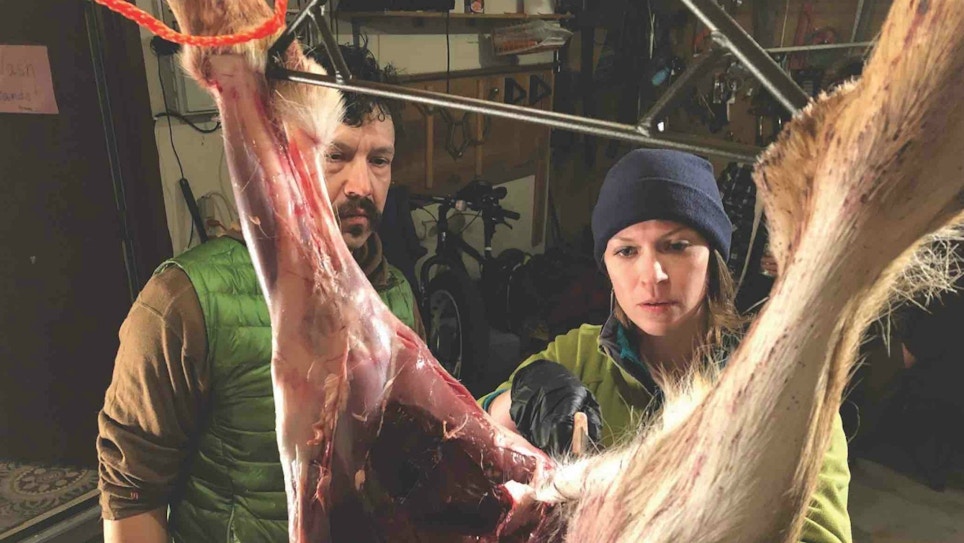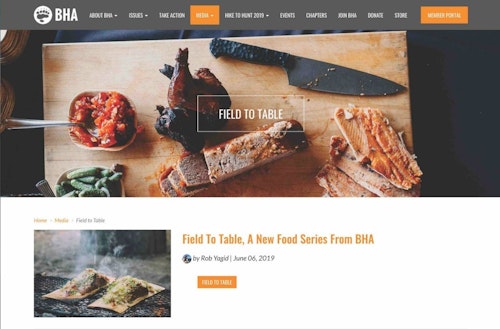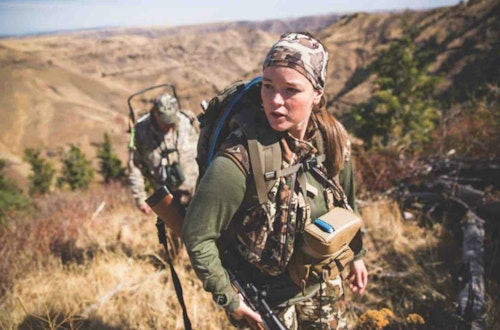
The organization Modern Carnivore works with entry-level hunters to showcase the importance of harvesting his or her own meals.
I’m excited about the evolution of today’s young hunters. As a whole, it seems they are heading back to hunting’s roots — to provide nourishment to the body, mind and soul. It’s about sharing with others and taking from the Earth, while respectfully giving back. I have never really been a big-buck hunter, so I admit to a personal bias here. Of course, not all new hunters are of the same background and mindset, and as such, there is no silver-bullet solution to recruiting them. However, there are a few trends to consider that I believe can help you grow your business.
Camaraderie in the Quest for Personal Growth
The inspiration for this article came from Dana Keller at A-1 Archery in Hudson, Wisconsin. She is an active participant and enthusiastic promoter of the Train to Hunt program, which is about competition and training your body. Dana said she participates because “I met so many people that want to carry out, fill the table and to be ethical and train throughout the year.” Blackhawk Bowhunters, a club with whom Train to Hunt often collaborates, has a member trainer, and interest seems to be growing.
“The camaraderie is insane,” Dana said. And the number of interested women is growing. Winning the competition isn’t the point at all — becoming healthier is. And who doesn’t want that? Encouragement is the key to help others grow, and Keller dishes it out in large helpings. The store will test archery fitness activities in 2019.
Anthony Schmidt of La Crosse Archery in Onalaska, Wisconsin, participated in the Wisconsin Train to Hunt event in 2017 and decided on another approach: team building. He put a team of staff shooters together the following year. “We engage in people’s lives so that they will be more engaged in our business”, Schmidt said. While he explained he couldn’t quantify the benefits yet, he sees immeasurable cultural changes. The group met weekly at Schmidt’s house to work out for up to 4 months before the 2018 Wisconsin Train to Hunt event. For other retailers, Schmidt suggested selecting specific staff and customers that match the program goals to test its fit with your business before developing a public program.
The purpose should be more than just getting together to work out. The program must include goals, both for individual participant improvement and for the program as a whole. Like Keller, Schmidt is an encouraging leader, and that is important for real program success.
La Crosse Archery has added an indoor Train to Hunt event to be held in 2019. As of the end of November, there were already 17 people that indicated on the Facebook event post that they’d be attending and another 55 expressed interest. Cost for the 1-day event is $65 per person. This shows that successful programs can take time to develop. Schmidt first participated himself, then built a staff team to participate, and is now adding public events in the store. They are creating a community that reaches beyond the traditional customer.

Using Food to Bring People Together
Steve Rinella of MeatEater fame spoke at a conference I attended several years ago. He explained that he used wild game food and mealtime discussion to introduce the topic of hunting to his non-hunting friends. The movement toward a more direct connection to food sources has been growing for many years, much to Rinella’s credit.
Modern Carnivore, based in my home state of Minnesota, introduces adults to “a lifestyle of direct harvest.” I recently spoke with founder Mark Norquist, who serves with me and approximately 20 others on the Minnesota Department of Natural Resources R3 Council. He explained that he sees an uptick in new people interested in hunting, fishing and foraging as ways to live a more holistic lifestyle focused on wellness. This year, the company released a seven-part film series called “Awaken the Hunter Within.” The film chronicles three beginning hunters and culminates in the sharing of a great wild game meal.
Modern Carnivore works with partners that include chefs, wild game food bloggers and conservation organizations to knock down barriers to entry into the hunting world. Through storytelling, they expose people to hunting who traditionally would never have considered the activity. Norquist summarized, “We have cultural challenges today, and hunting is a way to connect people through the common desire for healthy food.”
A 2017 report by Responsive Management showed that 39 percent of hunters were motivated “by meat,” which is up from 16 percent just a decade before. Inside the same report, 85 percent of American approved of hunting “for the meat,” the same percent that said they’d approve “to protect humans from harm.” People are certain to continue presenting their trophies at the end of the hunt — they just aren’t the primary motivator.
There are a number of ways to use these trends to adapt your business. Work with a local wild game chef to prepare a meal and invite people through a local grocer, food co-op or whole foods store. Invite participants to come early and provide information on where the animals came from, the process to acquire them and describe how the food will be prepared. Use storytelling to engage curiosity about hunting. Another option is to have a wild game cook-off. Shift the focus to new people, though, by asking existing customers to invite a non-hunter who might consider hunting. Then, have the non-hunting attendees describe their experience with the food and vote for the best dish. Finally, what about a cooking class? Hold a variety of classes based on game available each season. Be creative and intentional about bringing in new customers for these events. Most of all, make it fun.
Connecting to the Land
Most hunting businesses rely on the fact that public land is available. If you’re not paying attention to the issue locally, in your state and even federally (how many of your hunters go out-of-state?), then you are not protecting your future business, either. Luckily, more groups are forming in response to the loss and destruction of public land and natural resources.
One such group gaining momentum is Artemis Sportswomen, which is a program of the National Wildlife Federation with more than 6 million members. One of their strategic goals is to “develop a dynamic sportswoman’s community, representative of all walks of life, that comes together around a shared conservation vision that promotes camaraderie and a dedication to working, playing, and fighting for wildlife and wild lands together.” Their social media pages are constantly promoting both the enjoyment of land and wildlife as well as land enhancement projects. The approach of giving back as much or more than we take will have a positive effect on hunting’s future.
Backcountry Hunters and Anglers is another group making a mark. The group’s 2016 annual report showed an increase of 216 percent in membership in just 1 year. Their mission: “... ensure North America’s outdoor heritage of hunting and fishing in a natural setting, through education and work on behalf of wild public lands and waters.” Though started in the West, the group now has chapters in all but about 10 states and even in a couple of Canadian provinces. Among their many activities, they started a collegiate program in 2015 that is “key to fostering the next generation of conservation minded hunters and anglers and public lands advocates.” New hunters AND new advocates is a winning combination.
Is someone in your company paying attention to land issues? Do you know how your state’s public lands are managed? What are you doing to activate your customer base to help protect public lands? If you’re not doing your part, then you are a part of the challenges we face. Follow the lead of Artemis Sportswomen and do some public lands work as part of team-building, or maybe even plan an activity that will allow your customers to give back. The action doesn’t have to be big — you could even volunteer to help clean up or repair the local archery park. Contact the wildlife agency to see if there are local opportunities to volunteer to improve nearby public hunting lands. Don’t just talk about the loss of access — act for real change.

For Self, for Others, for Earth
Today’s hunters appear to be trending toward well-being and personal growth, which extends through appreciation and protection for public lands. The leaders are a younger, more aware, group of hunters, and that makes me hopeful. If you haven’t started listening to your 20- or 30-somethings, perhaps it’s time to do so. They have much to teach, and you have much to share. Listen to them first.
State wildlife agencies are encouraging mentoring as a way to introduce the benefits of hunting to others. Encourage your customers to bring a new person with them. Be aware of the state mentoring programs and actively promote them in your store. Partner with an organization to offer beginning bowhunting programs and/or take a new person yourself. The best mentors don’t tell — they ask questions to understand individual needs and goals and encourage curiosity. If your new hunter is most curious about food, then avoid talking about big bucks. Make your mentorship more about their learning and growth and less about your expertise and accomplishments. Remember the old adage about two ears and one mouth, and listen more than you talk.
As hunters, we already know the benefits to health and well-being of being outdoors and connecting with our food. Through the Pittman-Robertson Act, significant monies provide funding for wildlife conservation. However, it’s not enough — we’re losing ground, figuratively and literally. One final trend I hope will help change the tide is the field of ecopsychology. Psychologists have already taken note of what the disconnection with nature has done for our children’s psyche and the health of our environment. As more therapists see how time outdoors can improve mental health and start prescribing outdoor-related activities, maybe we have a chance grow interest in hunting as one of those activities. I am playing my role by teaching a workshop for therapists in ecopsychology this spring. I will be including an urban deer-related activity and briefly touching on hunting as a means to reconnect. It’s a stretch — I know. Transformation takes risks but can offer some of the best rewards.
A Parting Story
Last summer I had the opportunity to attend opening night of a movie titled Cold November, which included a Q&A session with the director and lead actor, Bijou Abas. Abas was a young teenager at the time of filming and grew up in the heart of Minneapolis, a real city girl with no prior experience with hunting.
Through her experience in attending hunter education, learning to shoot a gun and then participating in hunting activities, Abas found a new understanding of hunting and appreciation for its place in our society. What struck me most about the session was a question from a youngster in the audience about how it felt when she stuck her hand inside the deer. She made it safe to be curious. Abas said it was gross and cool at the same time; a bit unexplainable, she admitted. The deer had given its life but was giving life as well. The reaction by these urban audience members to a hunting movie convinced me that if we could reach beyond the images of antlers to food, nature and well-being, we might just be able to bring more people to the table.
Programs
You can learn more about these programs at the following links:
- Train to Hunt: www.traintohunt.com
- Modern Carnivore: www.modcarn.com
- Artemis Sportswomen: www.artemis.nwf.org
- Backcountry Hunters and Anglers: www.backcountryhunters.org






